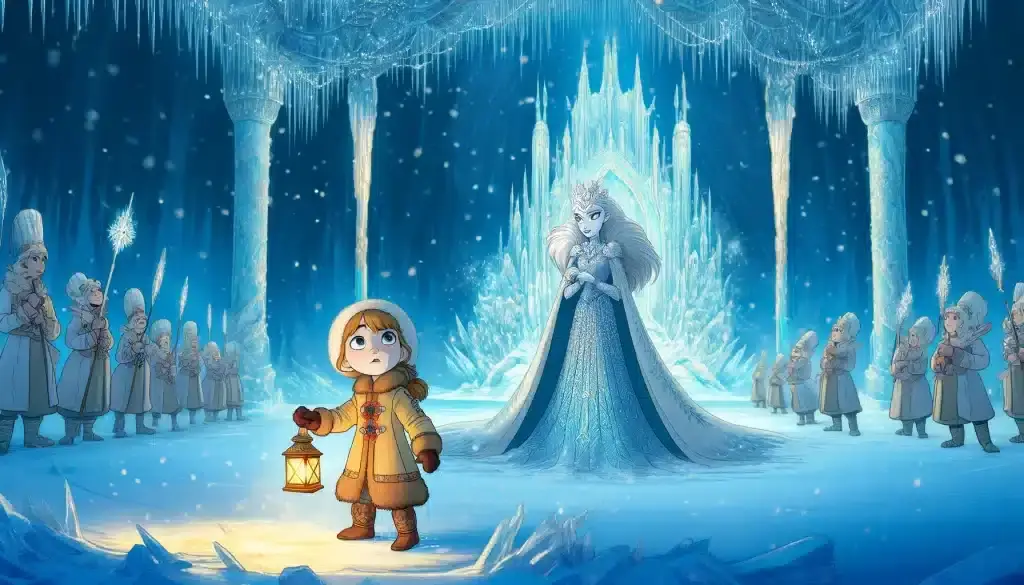The Snow Queen by Hans Christian Andersen is a captivating fairy tale that continues to enchant readers of all ages. It explores the classic battle between good and evil through the adventures of two childhood friends, Gerda and Kay.

Gerda and Kay’s story begins with a magical mirror that shatters, causing pieces to embed in Kay’s heart and eyes, transforming his view of the world. Kay’s abduction by the Snow Queen sets Gerda on a perilous journey to rescue him. The story is divided into seven short tales, each depicting different stages of Gerda’s unwavering search for Kay.
From enchanted gardens to the icy palace of the Snow Queen, each segment of the story draws the reader into a world of enchantment and peril. Andersen weaves a vibrant tapestry that speaks to the resilience of the human spirit, showing that even in the coldest of winters, warmth can be found in the most unexpected places.
For an in-depth look at this timeless classic, check out A Summary and Analysis of ‘The Snow Queen’ and delve into the magic behind Andersen’s storytelling.
Author Background

Hans Christian Andersen was a Danish author known for his timeless fairy tales. His life experiences and creative genius left a lasting mark on literature.
Life of Hans Christian Andersen
Hans Christian Andersen was born on April 2, 1805, in Odense, Denmark. Coming from a poor family, Andersen’s father was a shoemaker, and his mother worked as a washerwoman.
Despite his humble beginnings, Andersen’s passion for storytelling emerged early.
In 1819, he moved to Copenhagen with dreams of becoming an actor or singer. Though his early artistic pursuits were not successful, his dedication to writing flourished. Andersen published his first story in 1822, but it wasn’t until the 1830s that he gained recognition with works like “The Improvisatore.”
His travels across Europe also influenced his writing, allowing him to draw from diverse cultures and traditions. Andersen’s biographical details, often colored by a blend of personal struggles and triumphs, continue to inspire readers worldwide.
Influence on Fairy Tales
Hans Christian Andersen’s fairy tales have significantly impacted both literature and popular culture. Writing in the mid-19th century, his stories include whimsical narratives like “The Little Mermaid,” “The Ugly Duckling,” and “The Emperor’s New Clothes.”
Unlike traditional folk tales passed down orally, Andersen’s stories were original creations. They infused deeper themes and moral lessons, a hallmark that distinguishes his work.
His stories often address the struggle between good and evil, capturing the human experience’s essence.
Andersen’s influence is evident in countless adaptations, including animated films and theatrical productions. His ability to weave magic into everyday situations has made his tales a cornerstone of children’s literature, continuing to enchant readers across generations.
For more details, check out Hans Christian Andersen’s impact.
Literary Analysis

The Snow Queen by Hans Christian Andersen explores profound themes and employs rich symbolism and complex character development. The battle between good and evil, the symbolic mirror, and the growth of characters like Kay and Gerda form the heart of the story.
Themes of Good and Evil
The story’s main theme is the classic struggle between good and evil.
Gerda represents pure goodness with her unwavering love and determination to save Kay. On the other hand, the Snow Queen embodies the cold, detached evil, trapping Kay in her icy realm.
Andersen illustrates how love can conquer evil through Gerda’s relentless pursuit and ultimate success in rescuing Kay. This theme is encapsulated in the contrast between Gerda’s warm-heartedness and the Snow Queen’s chilling demeanor.
Symbolism of the Mirror
The mirror in The Snow Queen is a pivotal symbol. Created by a demon, the mirror distorts the reality, making everything good appear bad and vice versa.
When it shatters, its splinters wreak havoc, one tiny piece lodging in Kay’s eye and heart. This changes Kay’s perception, turning him cold and distant.
The mirror’s fragments serve as metaphors for how twisted perceptions can corrupt one’s view of the world, emphasizing the dangers of seeing through a lens of cynicism and negativity.
Character Development
Kay and Gerda undergo significant development throughout the story.
Kay starts as a loving and innocent boy, but the mirror splinter in his heart turns him unfeeling and harsh. His transformation back to his true self only occurs after Gerda’s tears melt the ice in his heart, showcasing the power of love and compassion.
Gerda’s journey, marked by her encounters with various characters and challenges, highlights her growth from a naive girl to a brave and determined heroine. This progression emphasizes the story’s message that true strength lies in the purity of heart and unwavering love.
Main Characters

In “The Snow Queen” by Hans Christian Andersen, three central characters drive the heartwarming tale. These characters embody the struggle between good and evil, and their adventures reflect themes of innocence, friendship, and the purity of heart.
Kay: The Little Boy
Kay, a central figure, experiences a drastic transformation in the story. Initially, he is a kind-hearted, playful boy who values his friendship with Gerda deeply.
The pivotal moment in Kay’s life occurs when pieces of a magic mirror lodged in his heart and eye, transforming his vision and emotions. This event symbolizes the corruption of innocence.
Trapped under the Snow Queen’s spell, Kay becomes cold and indifferent, his former joy replaced by apathy. Inside the Snow Queen’s palace, he forgets Gerda and the warmth of their friendship. Despite his bleak situation, Kay’s true essence shines through at the end, illustrating the triumph of love and purity over coldness and evil.
Gerda: The Little Girl
Gerda, Kay’s devoted friend and the story’s heroine, embodies loyalty, innocence, and unyielding determination.
When Kay vanishes, it’s Gerda who bravely embarks on an epic journey to find him. Her relentless quest symbolizes the power of unwavering love and the strength of human spirit.
Throughout her adventures, Gerda encounters various characters and overcomes numerous obstacles, guided by her pure heart and deep affection for Kay. Her innocence and goodness ultimately lead to her success.
Gerda’s tears of joy and love break the Snow Queen’s spell, restoring Kay to his former self and highlighting the story’s central theme of the victory of good over evil.
The Snow Queen
The Snow Queen herself is a formidable and enigmatic character.
She represents coldness, detachment, and the antithesis of warmth and humanity. As the story’s antagonist, she kidnaps Kay and keeps him in her icy palace, exerting control over his mind and heart.
Her character is often shrouded in mystery, with her dazzling white appearance and icy demeanor reflecting her frosty nature. Despite her power, the Snow Queen’s influence is ultimately no match for Gerda’s genuine love and perseverance. The defeat of the Snow Queen underscores the story’s moral that pure, selfless love is the most powerful force of all.
Plot Overview

“The Snow Queen” by Hans Christian Andersen weaves a tale of friendship, bravery, and enchantment through the adventures of Kay and Gerda. The story showcases their separation and the epic journey Gerda undertakes to rescue Kay from the icy grip of the Snow Queen.
Beginnings and Separation
Kay and Gerda are best friends living peacefully in a quaint village. Their lives change dramatically when a magic mirror shatters, spreading its fragments across the world.
Unfortunately, Kay is struck by these shards, which makes his heart cold and his vision twisted. He becomes distant and cruel, eventually falling into the clutches of the Snow Queen, who takes him to her palace made entirely of ice.
Gerda’s Journey
Determined to save her friend, Gerda embarks on an arduous journey.
Along the way, she encounters various characters who help or hinder her progress.
She meets a wise woman with a magical garden, friendly crows, and even a band of robbers. A reindeer becomes her loyal companion, guiding her through icy landscapes and treacherous conditions.
Gerda’s unwavering love and courage drive her to push on, despite the numerous obstacles.
The Snow Queen’s Palace
Gerda finally arrives at the Snow Queen’s Palace, a cold and imposing fortress where Kay is held captive.
Her tears and warm embrace manage to break the spell cast by the magic mirror.
Kay’s heart thaws, and he recognizes his dear friend once again. Together, they manage to escape the Snow Queen’s icy domain and return home. Their journey highlights themes of endurance, love, and the triumph of good over evil.
Setting and Imagery
Hans Christian Andersen’s “The Snow Queen” transports readers through diverse and vivid settings that enhance the narrative. The story’s landscapes, seasons, and magical elements play crucial roles in illustrating the journey of Gerda and Kay.
Landscapes and Seasons
The tale opens in a bustling city, embodying the warmth of human connection before transitioning to cold and desolate regions.
Winter’s harshness symbolizes the Snow Queen’s realm, emphasizing isolation and danger. Snowflakes appear as icy sentinels, eerily beautiful but relentless.
Conversely, the warmer seasons and vibrant landscapes signal safety and comfort. For instance, Gerda’s journey through spring meadows and blossoming fields showcases hope and rebirth, adding rich contrasts between light and darkness.
The Enchanted Flower Garden
Gerda’s encounter with the enchanted flower garden is a pivotal moment.
Here, flowers sing of the past and present, each type holding unique stories that allude to different facets of life and nature.
Roses, in particular, are central to her memories of Kay, symbolizing love and beauty.
The garden is a temporary escape from her perilous quest, filled with lush, colorful blossoms that deceive with their charm, underscoring themes of false security and forgotten duties.
The garden serves as a microcosm of the wider world, hinting at hidden dangers beneath alluring appearances.
The Frozen North
The narrative’s climax occurs in the Frozen North, a stark, treacherous landscape that embodies the Snow Queen’s power. Lapland and Finland, with their frigid climates, become crucial settings where Gerda finds allies and hope.
These frozen lands are depicted with chilling beauty—sheets of ice, drifting snow, and shimmering frost create a breathtaking yet dangerous backdrop. This harsh environment tests Gerda’s resolve and contrasts sharply with the warmth of human compassion she encounters.
The snowflakes here are more than just weather elements—they act as obstacles and protectors of the Snow Queen’s fortress, highlighting the narrative’s tension between human perseverance and natural adversities.
Symbolism and Metaphors
Hans Christian Andersen uses symbolism and metaphors in “The Snow Queen” to illustrate themes of good versus evil, the power of love, and the journey of self-discovery.
Key symbols include the enchanted mirror, the rose garden, and the red shoes, each adding depth to the tale’s narrative.
Mirror and Splinters
The enchanted mirror in “The Snow Queen” is a central symbol representing the distortion of reality and inner turmoil. An evil troll created this mirror, and it shatters into countless pieces, with splinters spreading chaos wherever they fall.
When a splinter lodges in Kay’s eye and heart, it corrupts his perception, turning beauty into ugliness and love into indifference. His once sunny nature becomes cold and distant, mirroring the chilling influence of the Snow Queen herself. These splinters highlight the struggle between good and evil within the human soul, showing how a tainted view can warp one’s reality.
Rose Symbol and Garden
The rose garden in the story epitomizes warmth, love, and purity. When Gerda finds herself amidst roses, they remind her of her beloved friend, Kay.
These flowers serve as a metaphor for her unwavering love and determination to save him.
Roses stand in stark contrast to the icy, lifeless realm of the Snow Queen, reinforcing themes of life and beauty versus death and coldness. Gerda’s encounter with the enchanted roses in the woman’s garden renews her hope and fortifies her resolve to rescue Kay, showcasing love’s power to persevere and triumph over hardships.
The Red Shoes
While the tale “The Red Shoes” is not part of “The Snow Queen,” its symbolism occasionally bleeds into Andersen’s works. In “The Red Shoes,” the footwear symbolizes obsession and the consequences of vanity.
Karen’s relentless dancing, driven by the cursed shoes, leads to her downfall, reflecting how unchecked desires can lead to self-destruction.
Even within “The Snow Queen,” the red shoes could be seen as reminders of the danger of losing oneself to superficial desires. They warn against allowing materialism or vanity to overshadow deeper, more meaningful pursuits, such as love and compassion.
Cultural Impact
“The Snow Queen” by Hans Christian Andersen has left an indelible mark on literature and popular culture. Known for its vivid storytelling and timeless themes, the tale has inspired numerous adaptations in various media forms.
Adaptations and Interpretations
Since its publication in 1844, “The Snow Queen” has spurred a plethora of adaptations. The story’s enchanting plot and complex characters have been translated into stage plays, musicals, and ballet performances.
Two notable adaptations include the 1957 Soviet animated film and the 2012 South Korean TV series, both showcasing diverse cultural perspectives on Andersen’s work.
The tale’s universal themes of good versus evil and the quest for redemption resonate across different interpretations. Each adaptation tends to emphasize different aspects, whether it’s the journey of Gerda, the icy enigma of the Snow Queen, or the mystical elements that enrich the narrative.
Snow Queen in Modern Media
In modern media, “The Snow Queen” continues to be a significant influence.
Perhaps the most famous is Disney’s smash hit “Frozen,” which loosely draws from Andersen’s tale. Elsa’s character, inspired by the Snow Queen, and Anna’s quest to save her sister echoes Gerda’s relentless search for Kay. Despite the creative liberties taken, the essence of Andersen’s story remains intact.
The tale also finds its way into literature, inspiring authors like C.S. Lewis, whose White Witch in “The Lion, the Witch, and the Wardrobe” shares similarities with Andersen’s queen. Moreover, video games and graphic novels have introduced younger audiences to this classic fairy tale, ensuring that “The Snow Queen” endures in the collective imagination for generations to come.
Educational Significance
“The Snow Queen” by Hans Christian Andersen offers rich educational value, making it a valuable addition to any classroom.
Its themes and structure provide numerous opportunities for teaching.
Moral Lessons
The tale emphasizes the triumph of good over evil, a fundamental lesson for children.
As Gerda embarks on her journey to save Kay, readers learn about bravery, love, and loyalty.
These moral lessons are easily integrated into character education programs.
Language and Vocabulary
Andersen’s language, with its vivid descriptions and enchanting imagery, helps improve children’s vocabulary.
Teachers can use specific passages to introduce new words and phrases, making the learning process engaging.
For example, the description of the Snow Queen’s icy realm is not only visually stunning but also full of new vocabulary.
Critical Thinking
“The Snow Queen” encourages critical thinking.
Each of the seven stories can be analyzed for its unique contribution to the main plot.
This segmentation helps students practice summarization and inferencing skills.
They can discuss questions like, “What qualities make Gerda a hero?” or “How does the Snow Queen symbolize different challenges?”
Cultural Understanding
Introducing children to classic European fairy tales broadens their cultural horizons.
Learning about different storytelling traditions and exploring themes common in various cultures fosters global awareness.
This is particularly relevant when discussing Andersen’s impact on the fairy tale genre.
Classroom Activities
Incorporating the story into various activities can enhance learning.
Teachers might use storyboarding to help students visualize the narrative or drama exercises to act out key scenes.
These interactive methods keep students engaged and deepen their comprehension.
Steve is the creative force behind My Unique Tales, a blog dedicated to sharing captivating stories that explore the human experience in all its complexity. With a passion for writing and a talent for crafting engaging narratives, Steve's blog is a treasure trove of imaginative tales that transport readers to other worlds and challenge them to see things from new perspectives. From epic adventures to intimate character studies, Steve's stories are always thought-provoking and emotionally resonant. With a growing following of readers who appreciate his unique voice and creative vision, Steve is quickly becoming a rising star in the world of online storytelling.






